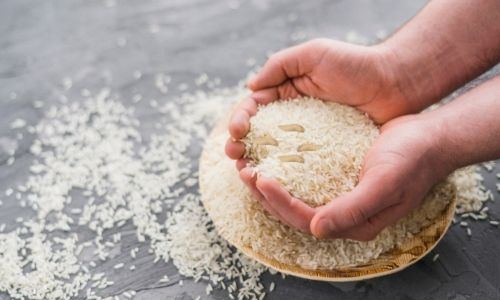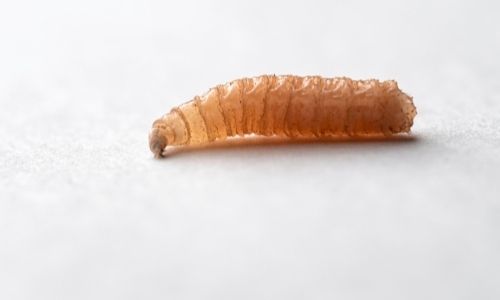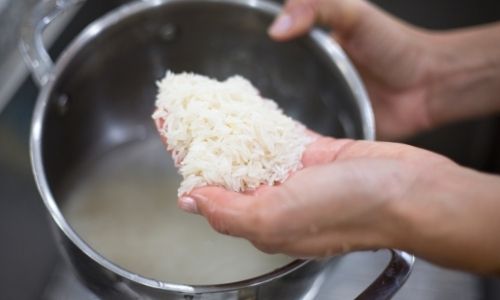
Rice is a pantry staple all over the world. It’s one of those foods you can buy in bulk and store for a long time.
But storing rice in bulk comes at a price. While storing rice, you might sometimes notice maggots hatching out. There’s no need to worry, though. This consequence can be prevented with the correct prevention techniques and proper storage methods.
Let’s discuss the reasons you might find maggots in your rice and look at the methods of prevention. We also teach you how to treat such rice and how safe it is for consumption if prevention fails.
How can rice turn into maggots?
Well, technically speaking, rice cannot turn into maggots. Rice is a grain, not an insect. However, when rice is exposed to open or dirty environments, it could get contaminated with fly larvae.
Such hatchlings can be dispersed via unprepared or rotten food. Although this is nothing to worry about, we would never advise you to consume any foods which contain live insects.
The starch in the rice makes for a good food source for the larvae after hatching.
How do maggots get into rice?

The first method maggots get into uncooked rice is because the grains carry eggs while they are processed for packaging.
The embryos in the grains have the potential to fertilize after being exposed to room temp for a longer duration of time. As a natural outcome, the rice will generate maggots, and your food will become spoiled.
Mature adult bugs sitting on the food once exposed and releasing eggs are the second reason larvae get into the rice.
What Do Rice Maggots Look Like?

Fresh produce may include maggots that stay hidden and are invisible to people due to their small size.
The larvae are generally off-white, but their appearance largely depends on the geographical location of the supply. They might be brown, redish, or nearly green.
Maggots resemble microscopic cream-colored worms, with the largest reaching a length of 20micrometres, or 3/4th of an inch. They do not have any limbs, but they do possess 2 minor snares, which act as jawbones to trap their prey.
You can look at your bag of rice through a magnifying glass to search for maggots.
How Do You Prevent Maggots & Other Bugs In Rice?
Here are a few things you can do to prevent maggot infestation in your rice.
1. Storage
Larvae can readily enter into cardboard and polythene bags, as we mentioned earlier. All food products should be kept in airtight, insect-proof packaging.
Other pests, such as ants and roaches, will be kept separate from your food as well. The vessel must be built of sturdy plastic, glass, or metal, ideally with a tight lid.
Note: It’s best not to mix fresh rice with the leftovers of old rice. Instead, keep it apart from the rest of the inventory and use it up first.
2. Repellents
Numerous organic pest repellents exist. Fill your cabinets with fresh cloves and bay leaves. Alternatively, soak a few cotton pieces in tea tree oil and place them around the containers.
Infestations are also deterred by putting strands of dry garlic and chilies.
3. Inspection
Make it a practice to inspect any fresh food products you purchase. By doing this, you will be able to return such contaminated goods to the retailer right away.
This should also prevent the infestation from spreading across your cupboard.
How to treat already-infested rice?
If you discover that you have an issue despite your safeguards, there are a few options for resolving it.
1. Refrigerate or Freeze For 24 Hours

Because these parasites prefer to thrive in warm, humid settings, you should be extra vigilant during the summertime.
Whenever you buy fresh goods, please keep them in their original packaging for a couple of days in the refrigerator. If any larvae or eggs exist, they will decimate them. Remove the frozen items from the fridge and reorganize them into appropriate storage containers.
2. Keep rice in sunlight
Most insects prefer the shade, so lay it out in a fine layer in the daylight for several hours when you have contaminated produce. You can accomplish this with the use of a tray. The pests should climb out from the plate in search of a shadowy place to hide.
3. Keep your kitchen clean
To get rid of any preexisting pests and prevent potential ones, start by giving your kitchen and storeroom a cleanup. Consider removing all edibles first.
Vacuum attentively, ensuring that all crevices, including gaps between shelves, are vacuumed. Vacuum behind and below the fridge, oven, breadbin, mixer, stove, and any place else where food particles can accumulate.
Using a chlorine-soaked towel, disinfect all surface areas. If you possess some clove oil, you could add two or three drops. Add a couple of teaspoons of peppermint oil if you can
4. Wash the rice

All preservation equipment that you wish to utilize for food should be washed adequately in warm detergent water.
Whatever larvae or maggots which might already be present will be killed prior to restocking. Simply make sure to rinse the vessels each time the past food stock runs out.
5. Boric Acid
You can use boric acid or boric powder to remove or prevent an infestation. All you need to do is mix your rice with a pinch of boric powder or boric acid.
Storing it using this method will likely prevent your rice from getting infested.
6. Heating
Similar to freezing, heating can use the high temperature to kill the maggot eggs from hatching. Simply heat your infested rice in the microwave at 14o-degree F for 15 minutes to kill the larvae. You can also try heating your rice at 120-degree F for 2 hours.
7. Bay Leaves/ Peppercorn
If the idea of mixing your rice with boric acid does not sit well with you, you can try placing some bay leaves, peppercorns, or cloves with your rice. Mixing such ingredients will prevent your rice from getting infected.
However, ensure that you keep your rice in an airtight container, or else this method will not work.
8. Oxygen Absorbers
Since maggots require oxygen t hatch into larvae, you can use oxygen absorbers to remove the oxygen from the substances.
You can place these small sachets in the rice container. Avoid spreading the product or ingesting it into the rice, as it can cause poisoning.
What Happens If You Eat Rice With Maggots?
While no one likes to eat bugs, many individuals nowadays don’t find it sustainable to throw out a large amount of rice or flour. The product is still safe for consumption, but you should get rid of as many vermin as possible.
FAQs
What foods bring maggots?
Apart from rice, you might find maggots infesting your meat, eggs, fish, etc. They will lay eggs in such food items, in addition to live animals or human flesh that is exposed due to injuries.
What type of bugs lives in rice?
You might find your rice getting infected by various types of bugs like flour bugs, weevils, maggots, pantry beetles, etc. The absence of proper storage methods can lead to such destructive infestation.
Can maggots survive cooking?
Maggots can survive cooking unless the temperature is at least 120-degree F. This is why if you want to remove the maggots from your rice, it is advisable to cook or heat them at a high temperature.
Why are there flying bugs in my rice?
Flying buts, or weevils, are similar to pantry pests that feed on rice, cereals, corn, beans, nuts, etc. However, unlike beetles that feed on foods, these flying buys, or weevils, live inside the food.
Conclusion
We now know that rice cannot turn into maggots, but it provides the requirements for fly larvae to hatch. The majority of the time, ingesting infested rice is not harmful.
Fortunately, there are various methods for killing the eggs and preventing their hatching. The most effective strategies are washing the rice, freezing it, keeping it under sunlight, and cleaning your kitchen.
Using natural repellents such as bay leaves and cloves is also really helpful. How have you gotten rid of maggots in your rice? Please write to us to let us know.



